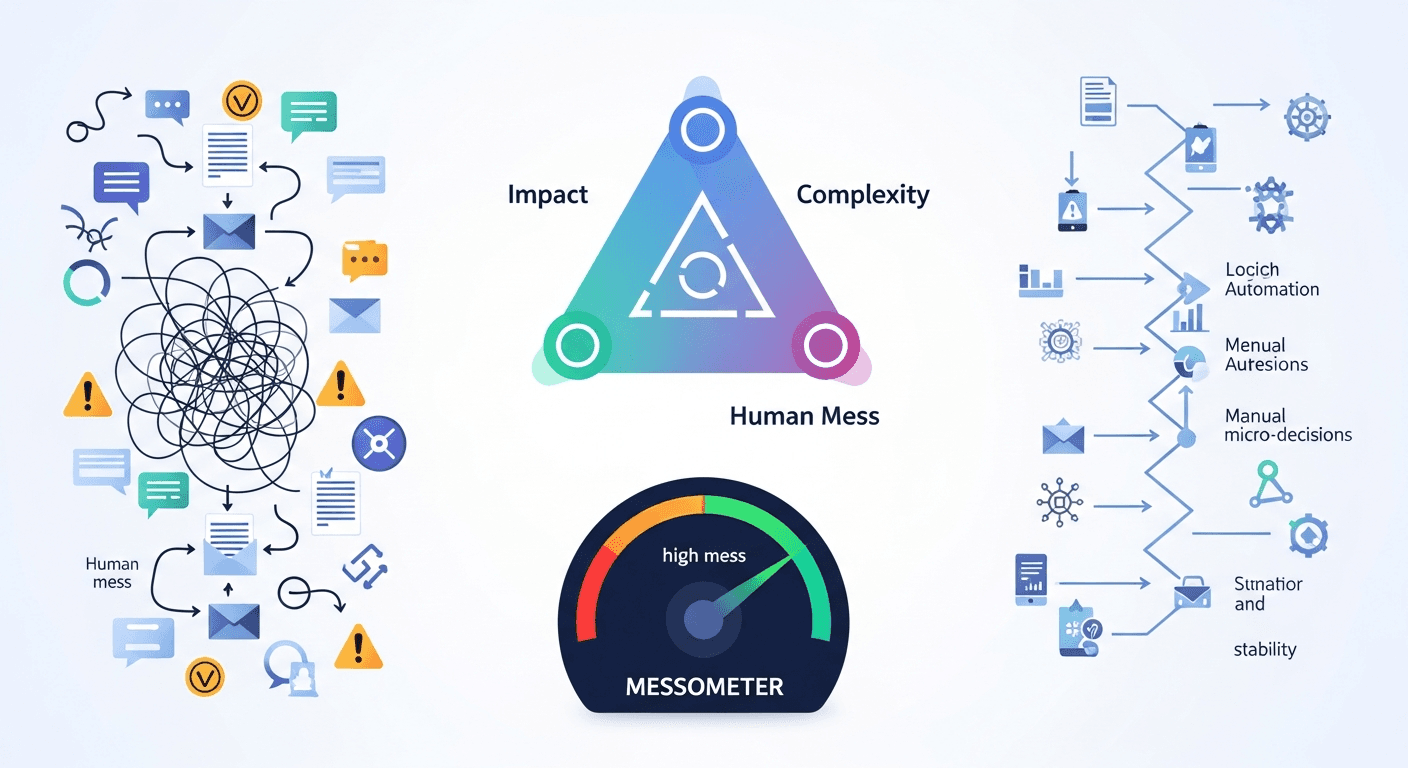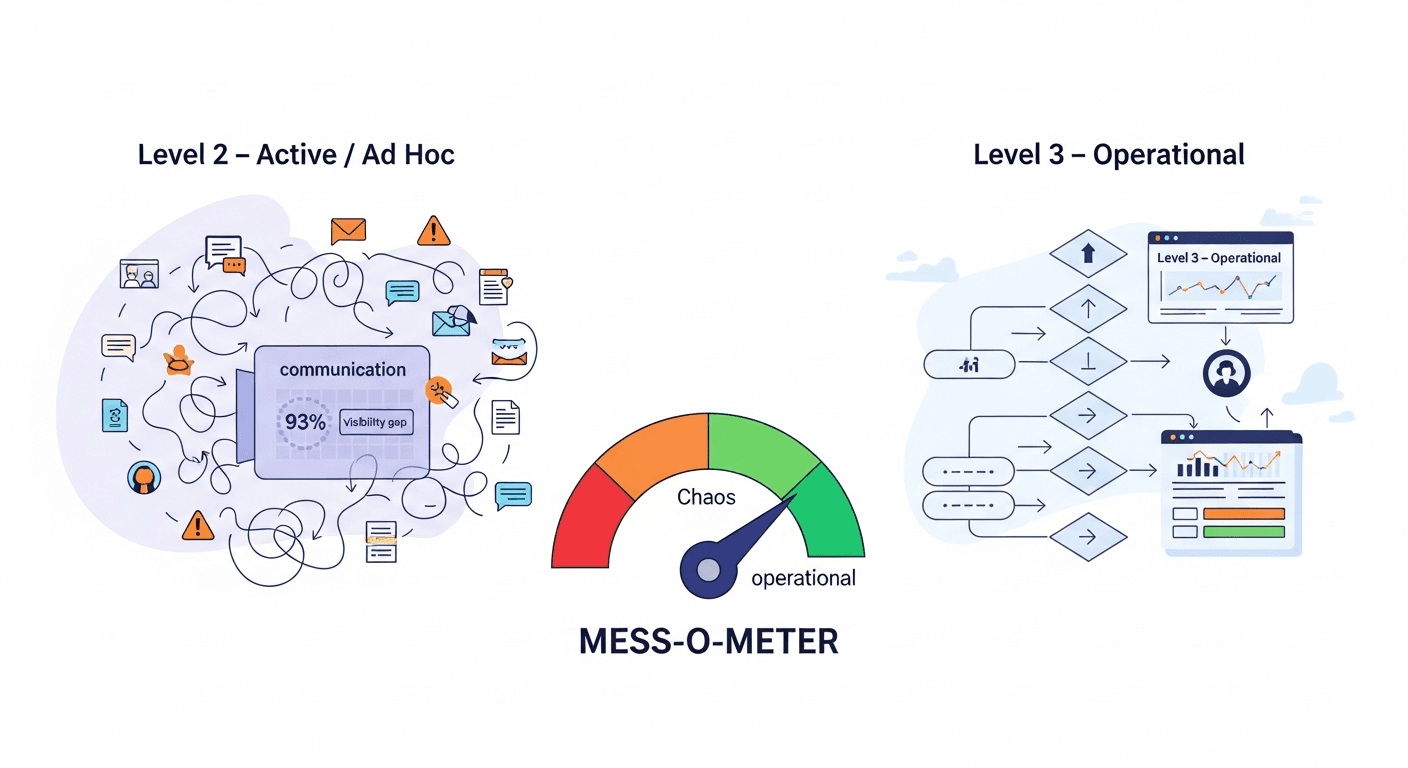Tuesday, 11 Nov 2025
|7 Ways the Mess-O-Meter Works with the AI Maturity Model

How Mess-O-Meter Work with AI Maturity Model
Understanding how the Mess-o-meter connects with the Gartner AI Maturity Model is one of the most important steps for any organization preparing to use artificial intelligence in a practical and strategic way. Many companies want AI, but they don’t know where to start, what to fix first, or why their AI efforts always stay stuck at the “pilot” stage. That’s where the Mess-O-Meter comes in—it reveals the hidden chaos blocking progress and ties directly into the maturity levels defined by Gartner.
In this article, you’ll learn exactly how the Mess-O-Meter works, how it pairs with the AI Maturity Model, and how organizations can use both tools to build a smarter, faster, more automated future.
Understanding the Mess-O-Meter in Modern Organizations
What the Mess-O-Meter Measures
The Mess-O-Meter is a practical diagnostic tool designed to measure the “Human Mess” inside organizations. While most leaders think their problems are technical, the truth is that most delays and errors happen in the everyday places where humans communicate, improvise, and make small decisions.
The Mess-O-Meter highlights issues such as:
- Chaotic workflows no one has ever formally documented
- Overused communication channels like email and chat
- Manual checks that slow processes down
- Reliance on tribal knowledge
- Siloed teams that don’t share information
Instead of guessing where inefficiencies exist, the Mess-O-Meter gives organizations a numerical score that pinpoints where work consistently breaks down.
Why Human-Driven Chaos Blocks Automation
AI cannot automate what it cannot understand.
If a process changes every time a different employee handles it, or if the rules only exist “in someone’s head,” automation becomes impossible. That’s why organizations stuck at the lower end of the AI maturity scale are often buried in:
- Redundant approvals
- Constant re-clarification
- Manual data entry
- Confusing handoffs
The Mess-O-Meter exposes these issues so they can finally be addressed.
Overview of the Gartner AI Maturity Model
The Five Levels of AI Maturity
The Gartner AI Maturity Model provides a standard way to evaluate an organization's readiness to adopt AI. The five levels include:
Awareness – AI conversations but no strategy
Active – Early experimentation with inconsistent results
Operational – AI used in limited but structured ways
Systemic – AI integrated into core operations
Transformational – AI defines the value proposition and competitive advantage
Most organizations think they’re at Level 3, but they’re actually between Levels 1 and 2—typically because of the “human mess” that the Mess-O-Meter detects.
Seven Pillars That Determine AI Readiness
The model evaluates maturity across seven areas:
- Strategy
- Product
- Governance
- Engineering
- Data
- Operating Models
- Culture
Weakness in any pillar slows down AI progress, especially when human-driven inconsistencies aren’t addressed.
How the Mess-O-Meter Complements the AI Maturity Model
Diagnosing the Human Mess That Holds AI Back
The Mess-O-Meter functions like an investigative lens. It identifies the root causes that keep organizations stuck in the lower maturity levels. Many leaders assume they need more technology, but in reality, they need less human friction.
Revealing the Visibility Gap
Research shows that 93% of organizations lack visibility into the human-dependent steps that create delays. These steps—conversations, clarifications, and exceptions—are invisible in traditional process maps.
The Mess-O-Meter makes the invisible visible.
Step-by-Step: How Mess-O-Meter Data Fuels AI Maturity Progress
Step 1: Measuring Chaos and Friction
First, the Mess-O-Meter identifies where work stalls. This creates a baseline score that shows how much chaos exists in a process.
Step 2: Triangulating Mess, Impact, and Complexity
Next, the Mess-O-Meter feeds directly into a structured decisioning model. This model considers:
- Where the mess is the highest
- The impact of fixing it
- The complexity of solving it
This creates a focused roadmap instead of guesswork.
Step 3: Building a Targeted AI Automation Roadmap
Once priorities are clear, organizations can map where AI should go first. This shifts AI from vague ideas to actionable automation.
Step 4: Deploying AI Where It Actually Matters
AI is then deployed to eliminate the high-mess workflows. This is how organizations climb the AI maturity ladder—from chaotic to operational to systemic.
Real-World Symptoms of Low AI Maturity Identified by the Mess-O-Meter
Excessive Communication Channels
Too many emails and chats signal poor process clarity.
Tribal Knowledge and Siloed Workflows
When only one person “knows how things really work,” automation is impossible.
Redundant Manual Decisions
Any repeated judgment call is an AI opportunity.
How AI Solves the Mess: Practical Use Cases
Intelligent Workflow Automation
AI removes unnecessary steps and compresses cycle times.
AI Agents Replacing Manual Micro-Tasks
Small, repetitive decisions can be taken over by automated agents.
AI-Driven Process Standardization
AI enforces consistency based on rules extracted from existing workflows.
See your Mess-O-Meter in minutes.
Frequently Asked Questions
1. What is the Mess-O-Meter?
It’s a diagnostic tool that measures workflow chaos to identify automation opportunities.
2. How does it support AI maturity?
It points to the exact processes that keep an organization stuck at lower maturity levels.
3. Can AI start without fixing the mess?
No—AI fails when processes are inconsistent or undocumented.
4. Do all departments have a Mess-O-Meter score?
Yes, every team with human-driven workflows can be measured.
5. What’s the biggest barrier to AI maturity?
Human bottlenecks and undocumented rules.
6. How do organizations use the score?
They prioritize AI investments using a structured decisioning framework.
Conclusion
The Mess-O-Meter and the Gartner AI Maturity Model work together as a powerful, practical system. The Mess-O-Meter identifies the chaos. The Maturity Model defines the goal. And together, they create a clear roadmap toward operational excellence and transformative AI adoption.
Learn more about AI maturity concepts at trusted resources like Gartner.
All blog posts
View All →
Tuesday, 18 Nov 2025
AI Prioritization with the Mess-O-Meter Framework
Triangulate impact, complexity, and human mess with the messometer to prioritize AI projects scientifically and reduce failure risk.

Monday, 17 Nov 2025
Escape Level 2 AI Maturity with the Mess-O-Meter
Use the messometer to measure manual micro-decisions and chaotic workflows so you can move from ad hoc AI experiments to operational, scalable AI.

Saturday, 15 Nov 2025
The 93% Visibility Gap: Why the Mess-O-Meter Is Your Powerful First Step in the AI Maturity Journey
Discover how the messometer exposes the hidden “communication black box” in your workflows. Learn why diagnosing this 93% visibility gap is essential before any AI implementation to avoid failure.